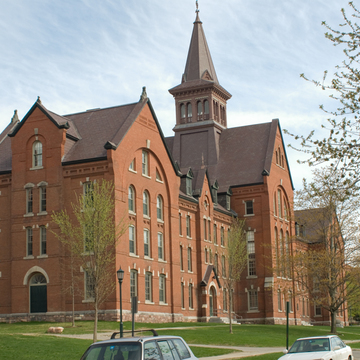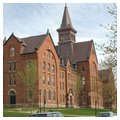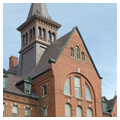Within a year of the destruction of the College Edifice by fire, it was rebuilt as three aligned three-story units with eight-foot breaks between them to protect against another conflagration. First constructed were the two end buildings, with multiple chimneys and end parapets, similar in character to Middlebury's Painter Hall (AD30.1). The central unit was nine bays, with a three-bay pavilion housing an upper-level chapel with tall arched windows and a gilded dome. In 1846, the fire-breaks were filled to create what was then the largest building in the state, two hundred and fifty feet in length. Because its long severe facade was reminiscent of large New England factories, it was nicknamed “Old Mill.”
A gift from local benefactor John P. Howard transformed the building again in 1882–1884. Rutland architect J. J. R. Randall added a fourth floor under steeply pitched roofs, expanded the ends as gabled masses, and inserted gables over the infill sections. He also reworked the facade with arched windows and polychromy, elevated the central pavilion, and replaced the dome and belfry with a spired belvedere dubbed “the birdcage.” He embellished the remodeled chapel (now the John Dewey Lounge) with tall memorial windows by James Ballantine and Sons of Scotland. Tiffany Studios of New York City added other windows in 1917.
In 1997 Old Mill was restored, and, utilizing themes from Randall's vocabulary, the central zone extended eastward to link with a remodeled International Style Lafayette Hall. This created twin courtyards that reveal the untouched window patterns of 1825. The university's effort to work with and enhance its historic heritage marked a shift away from the modernist designs of the preceding decades.





